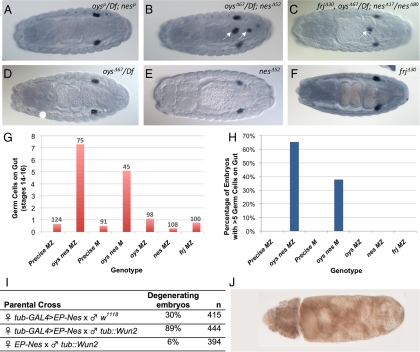Figure 7.
oys nes mutants show abnormal germ cell migration. (A–F) By stage 14 of embryogenesis, the germ cells (stained with anti-Vasa in purple) associate with the somatic gonadal precursors and form two bilateral clusters. Embryos from mothers carrying precise excision alleles of oys and nes show no defect in this process (A), in contrast to embryos from oys nes double mutant mothers (B, arrows), or oys nes frj triple mutant mothers (C, arrow), in which some germ cells remain associated with the gut. Mothers singly mutant for oys (D) or nes (E) produce embryos with normal germ cell migration. Embryos from frj mutant mothers are also normal (F). (G and H) Quantification of the germ cell migration phenotype reveals that embryos lacking maternal oys and nes (M) have an average of five germ cells associated with the gut by stage 14, and removing paternally contributed oys and nes from half the embryos (MZ) increases this number to 7 (G). The number of embryos counted is given above each column. Thirty-eight percent of embryos lacking maternal oys and nes (M) have more than five germ cells associated with the gut by stage 14, and the penetrance is increased to 65% when one copy of paternally contributed oys and nes is removed from half the embryos (MZ; H). Control embryos laid by mothers carrying precise excisions of both genes (Precise M, Precise MZ) and single oys, nes or frj mutants show no significant germ cell migration defects (G and H). Embryos showing membrane degeneration were not included in the quantitative analysis. (I and J) nes interacts genetically with wun2. Maternal overexpression of Nes causes 30% of embryos to degenerate, whereas co-overexpression of Nes and Wun2 causes both quantitative and qualitative enhancement of the phenotype. Zygotic overexpression of Wun2 alone causes only 6% of embryos to degenerate (I). An example of a degenerating embryo overexpressing both Nes and Wun2 is shown in J.

